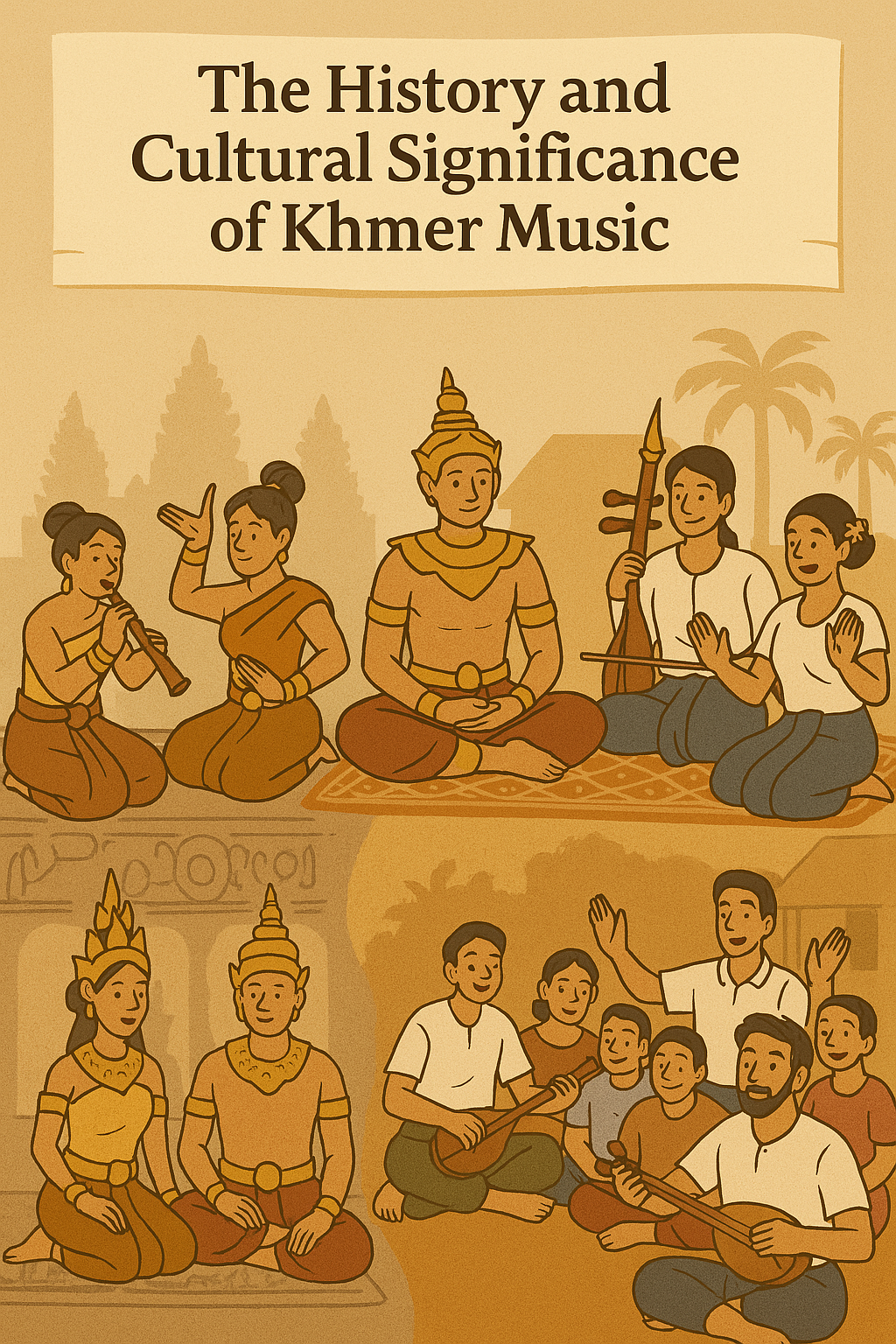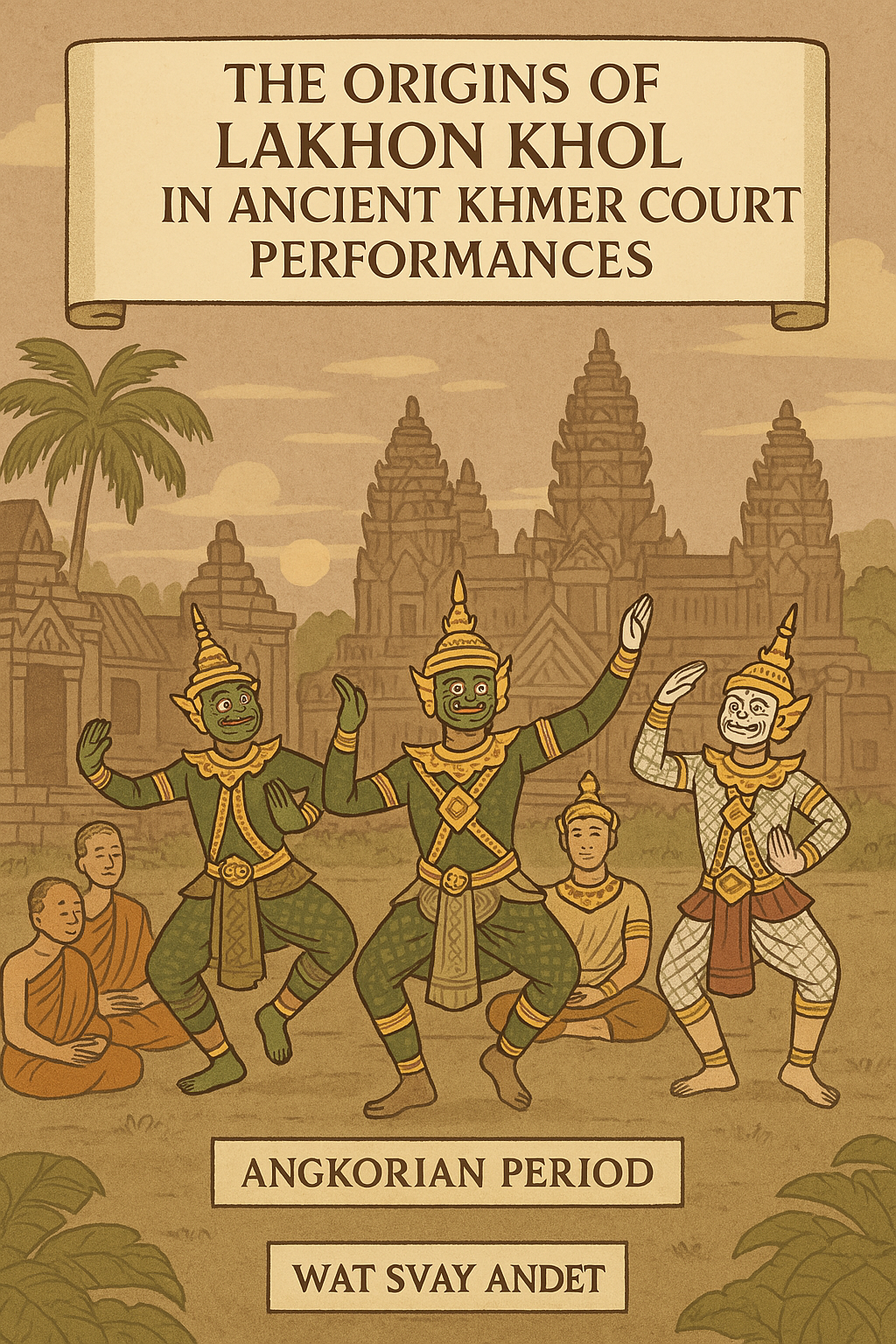Khmer music is more than melody—it’s a spiritual bridge, a storytelling device, and a cultural thread that ties past to present. From royal courts to rural temples, traditional Cambodian music has shaped identities, conveyed sacred teachings, and accompanied the dance of the divine and human alike. Despite facing periods of silence, especially during the war, the heartbeat of Khmer music still resonates across the land.
1. The History and Cultural Significance of Khmer Music
The roots of Khmer music stretch back to pre-Angkorian and Angkorian times, when music was integrated into:
- Royal rituals
- Religious ceremonies
- Theatrical performances
- Village festivals
Inscriptions and bas-reliefs at Angkor Wat, Bayon, and Banteay Srei depict orchestras with flutes, gongs, harps, and drums. Music was seen as both sacred and political, used to elevate the aura of kings and connect worshippers to the divine.
Khmer music is deeply pentatonic, favoring five-note scales that create a serene, cyclical atmosphere—ideal for meditation, storytelling, and ceremonial procession.
2. Pin Peat Ensemble: The Orchestra of Cambodian Classical Music
The Pin Peat (ពិណពាទ្យ) ensemble is the most iconic classical Khmer orchestra, traditionally used for:
- Royal ceremonies
- Buddhist rituals
- Classical dance (Apsara, Lakhon Khol)
- Shadow puppetry (Sbek Thom)
🔊 Instruments include:
- Roneat Ek & Roneat Thung: High and low xylophones
- Samphor & Skor Thom: Sacred barrel drums
- Sralai: A piercing quadruple-reed oboe
- Kong Vong Thom: Circular gongs arranged by pitch
Pin Peat music is hypnotic and powerful, designed to command spiritual attention and ceremonial reverence. Its players are highly trained, and performances are often considered a sacred offering rather than entertainment.
3. Mahori Music: Traditional Entertainment for Khmer Royalty
Unlike the solemn tone of Pin Peat, Mahori (មហោរី) is more gentle, melodic, and lyrical—traditionally performed to entertain Cambodian royalty and nobles.
Features of Mahori:
- Instruments are similar to Pin Peat but often played softer
- Includes vocals, with lyrics from classical poetry or love stories
- Accompanies folk dance, banquets, and light ceremonial gatherings
Mahori emphasizes grace and beauty, making it ideal for storytelling and ambiance in elegant social settings. It was especially prominent during the post-Angkorian and royal court eras, particularly under King Norodom Sihanouk’s patronage in the 20th century.
4. Chapei Dong Veng: The Storytelling Lute of Cambodia
The Chapei Dong Veng (ឆាភីដងវែង) is a long-necked, two-stringed lute central to Cambodia’s folk and moral tradition. It’s not just an instrument—it’s a voice of the people.
Characteristics:
- Played solo or with light percussion
- Used to accompany improvised poetic storytelling (usually humorous, satirical, or spiritual)
- Lyrics often teach ethics, religion, or social commentary
Kong Nay, a blind master of the chapei, is a national icon whose deep voice and witty verses captivated audiences for decades. This tradition remains alive through oral transmission, apprenticeships, and cultural revival efforts.
5. Khmer Flutes, Drums, and Xylophones: Their Roles in Different Performances
Cambodian music features a variety of indigenous instruments beyond the major ensembles:
🎵 Wind:
- Khloy: End-blown flute used in folk and spiritual music
- Sralai: Key instrument in Pin Peat, with a sharp and nasal tone
🥁 Percussion:
- Skor Thom: Double-headed sacred drum
- Samphor: A small hand-held drum used in ceremonial rhythms
- Chhing: Finger cymbals marking time for dancers
🎼 Xylophones:
- Roneat Ek (high-pitched) and Roneat Thung (low-pitched) form the melodic core of Khmer orchestras
Each instrument plays a specific ceremonial or narrative function, helping to shape mood, movement, and timing in dance, theater, or prayer.
6. The Relationship Between Khmer Music and Buddhist Ceremonies
Khmer music is inseparable from Theravāda Buddhist rituals, used in:
- Ordinations (Pithi Sampeah Preah)
- Funeral rites
- Water blessing ceremonies
- Pchum Ben and Kathina festivals
Monks and laypeople alike engage in chanting accompanied by Pin Peat or solo percussion, intended to invoke protection, merit-making, and spiritual reflection. Instruments like gongs and drums mark important ritual moments or processions.
In this context, music becomes meditative and devotional, serving as a pathway between the earthly and spiritual realms.
7. How Cambodian Music Was Affected by the Khmer Rouge
Under the Khmer Rouge (1975–1979), Cambodian music suffered catastrophic loss:
- Thousands of musicians, singers, and instrument makers were killed
- Traditional instruments were destroyed
- Temples and cultural centers were desecrated
The regime viewed traditional music as elitist and unnecessary. Surviving musicians went underground or fled.
After 1979:
- Survivors began teaching from memory
- NGOs and institutions like Cambodian Living Arts revived lost instruments and songs
- Youth music academies now train new generations in classical and folk traditions
Despite immense loss, Cambodian music today represents a powerful revival, proving the resilience of Khmer culture through sound.
Conclusion: A Culture Carried by Sound
Khmer traditional music is not just about performance—it’s about preservation, identity, and spirituality. Whether it’s the grand crescendos of the Pin Peat, the lyrical charm of Mahori, or the earthy wisdom of the chapei, Cambodia’s musical landscape echoes the voices of its past, rising strong into the future.
As long as these sounds continue—on stage, in temples, in villages, and in hearts—the Khmer spirit sings on.





